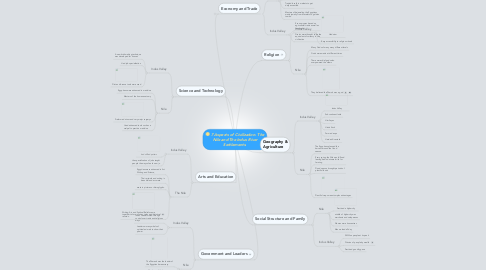
1. Science and Technology
1.1. Indus Valley
1.1.1. A new brick making technique was developed for houses
1.1.2. Had job specialization
1.1.3. Flint and bronze tools were used
1.2. Nile
1.2.1. Egyptians were advanced in medicine
1.2.2. Masters of the human anatomy
1.2.3. Preformed minor and very major surgerys
1.2.4. Used advanced tools such as a scalpel to practice medicine
2. Arts and Education
2.1. Indus Valley
2.1.1. had skilled potters
2.1.2. the specialization of jobs taught people the ways of each new jo
2.2. The Nile
2.2.1. Egyptians were advanced in Art Writing and Science,
2.2.2. Their artwork and writing is beautiful and accurate.
2.2.3. wrote in pictures or hieroglyphs.
2.2.4. Writing, Art and Spiritual Beliefs came together to form stories, tales and historical records.
3. Government and Leaders
3.1. Indus Valley
3.1.1. Indus Leaders ruled through control over trade and religious ways
3.1.2. Leaders wore symbols of spiritual animals to show their power
3.2. Nile
3.2.1. The Pharaoh was the leader of the Egyptian bureaucracy.
3.2.2. Members of the bureaucracy would act on the Pharaohs decisions.
3.2.3. The Pharaoh was believed to be a god
3.2.4. Slaves were used to construct pyramids, slaves were criminals and wrongdoers
4. Economy and Trade
4.1. Nile
4.1.1. As master craftspeople, the Egyptians had luxurious goods
4.1.2. Traded with travelers
4.1.3. Traded locally in markets to get daily essentials.
4.1.4. Masters of bejeweling the Egyptians made jewelry from bracelets to golden tombs.
4.2. Indus Valley
4.2.1. Economy was based on agricultural trade as well as livestocks
4.2.2. Grains were thought to be the equivalent of currency in the civilization
5. Religion
5.1. Indus Valley
5.1.1. Hinduism
5.1.2. Easy accessibility to religious rituals
5.2. Nile
5.2.1. Many Gods of many many different levels
5.2.2. Gods were made at different times
5.2.3. There were chief gods who overpowered the others
5.2.4. They believed the Pharoh was a god
6. Geography & Agriculture
6.1. Indus Valley
6.1.1. Indus Valley
6.1.2. Subcontinent India
6.1.3. Himilayas
6.1.4. Hindu Kush
6.1.5. Farmed crops
6.1.6. Herded Livestock
6.2. Nile
6.2.1. The Egyptians planned the harvest around the flood season.
6.2.2. Every spring the Nile would flood leaving behind minerals rich for farming
6.2.3. Flood season brought periods of plentiful foods
6.2.4. Plentiful crops meant surplus advantages
7. Social Structure and Family
7.1. Nile
7.1.1. Practiced a higharchy
7.1.2. middle of higharchy was merchants and salepersons
7.1.3. Women were housewives
7.1.4. Men worked all day
7.2. Indus Valley
7.2.1. 5 Million people at its peak
7.2.2. Division of people by wealth
7.2.3. Practiced good hygene
